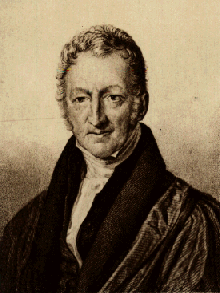|
|
Malthusian Myths
The Error of Population Control |
|
|
Malthus
Or, couched in other mathematical terms, population (otherwise unchecked) increases exponentially, while sustenance increases linearly. We can illustrate this in graphic form in the chart below and to the right. |
||
|
In the graph to the right, population
(red line) is increasing exponentially up to point A, while food supply (green line) is
increasing linearly.
This depiction represents a new population from time zero to some point in time (A) where the natural environment cannot further increase food supply, and agriculture and farming are necessary to support additional population growth. At Point B, the limit is reached to support a human population, and no further growth can be accommodated -- the food supply reaches a limit, (arable land and water) which does not support any further population growth. Without further constraint, such a birth control, the population maintains a more or less constant level by infanticide, senicide, and some portion of the population starving. |
|
|
|
First Counter Argument Everything that humans eat are living things. And every living thing also reproduces in a manner that produces an exponential population growth. So our food supplies should be able to match our human population growth thru proper agricultural and farming practices.
Malthus answer The animal food chain populations, to which all living things belong, are ultimately supported by a plant and microbe populations that depend on a dedicated surface area of minerals and soils. The output of plant production cannot increase except by exploiting more surface area. Surface area exploitation (according to Malthus) is linear. At some point, the surface are (for example, tillable land) is finite, and food supply becomes finite and fixed..
Natural Population Limiters The natural population limiters are events that tend to be continually killing off segments of a population, The traditional limiters of the human populations are the colloquially known as the four horsemen of the apocalypse -- War, famine, pestilence, and (natural) death. We can add a few more -- natural disaster, chaos, and social breakdown. Of these natural population limiters, Malthus was primarily concerned with starvation from famine, and quality of life. When we look at primitive human populations, such as remote clans and tribes of hunter-gatherers -- those who live off the natural land, without much, if any, crop cultivation, they do indeed all seem to be small populations that are especially subject to the four horsemen -- and especially famine from drought.
Assumption versus fact Malthus made the observation that to increase crop yield required a proportionate increase in arable land -- for example, to double crop yield required the doubling of crop land. That was an accurate observation at the time, and a given in his day, when one thin crop a year was the best expectation. But it was only an assumption that it was some kind of immutable law. In fact, modern agricultural science has increased crop yield an order of magnitude since Malthus's time -- one acre of land today can produce ten times what the same acre in Mathus's time could produce. Also, the world population has also increased an order of magnitude since the time of Malthus, from approximately 750 million, to 7 billion today. All dire predictions of impending doom have proved false. Today we produce far more food supply than we consume. In fact, the worry among modern agriculture is price-destabilizing over-production, not under-production.
Future Food Supply There are still dire warning abounding everywhere of the imminent collapse of the world food supply. And it is certain that primitive societies will still be victim to the vagaries of nature, and in particular, to the weather. And political instability threatens some societies, which could seriously interrupt food supplies locally. But the global food supply is sufficiently diversified and spread out to weather localized disturbances, And there is no natural situation that modern societies cannot improve dramatically with good engineering, such as dams, redirecting rivers, irrigation of deserts, and desalination of sea water. As well as methods to produce multiple crops per year, and enclosures to extend the growing season in cooler climates. And we are still primarily producing on a single horizontal surface. We have yet to fully exploit agriculture and farming on a vertical scale -- where growing beds are layered on top of each other. |
||




